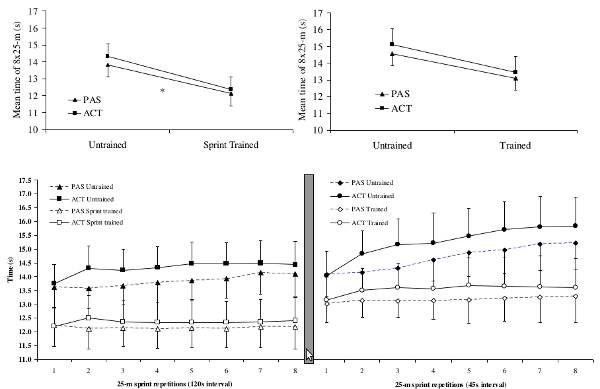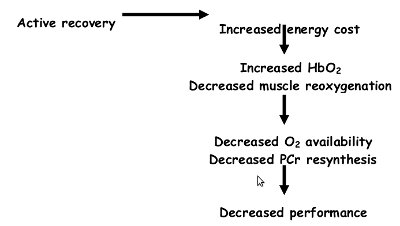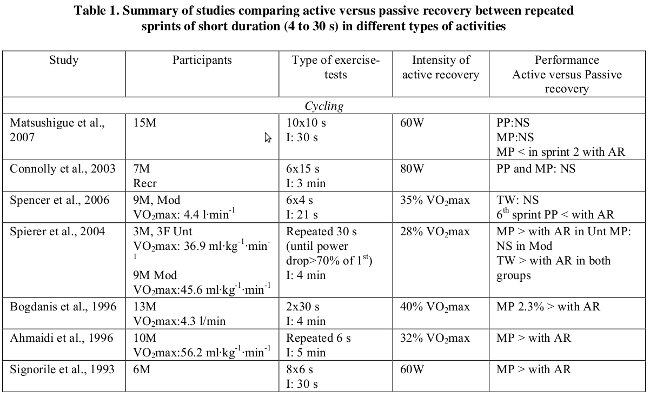ACTIVE RECOVERY AND RESTORATION OF PERFORMANCE

Active Recovery versus Passive Recovery between Short Duration (4 to 30 s) Sprints
Sprints of very short duration (2 to 4 s) are frequently used during team sports, while sprints of 5 to 30 s appear during individual competitive sports.
In addition, training sessions of many sports include activities of this duration performed with a maximum intensity. These sprints may be performed with different intervals depending on the training purpose. In this case, it is possible that the changes in performance with successive bouts will be affected by active recovery within the interval.
Performance in cycling and running sprints
Early studies used repeated sprint protocols to examine the effects of active recovery on performance. The studies of Signorile et al., (1993) and Ahmaidi et al., (1996) showed that active recovery could be beneficial to performance. Signorile et al., (1993) applied a set of 8x6 s cycling sprints with a 30 s interval. Mean power was better after active recovery compared to passive recovery. Similarly, performance was improved when the same duration sprints (6 s) were applied with a 5 min interval; especially during sprints with a high resistive load (i.e. 6 kg; Ahmaidi et al., 1996). However, a cycling protocol applying 10x10 s sprints with 30 s intervals demonstrated no significant difference in mean and peak power after active or passive recovery (Matsushigue et al., 2007). A repeated sprint protocol with short duration sprints that simulates team-game sprint duration has been applied (6 repetitions of 4 s sprints with 21 s interval) and has also been tested after active recovery. Nine male moderately trained individuals followed this protocol during cycling sprints in the study of Spencer et al., (2006). The total work produced was not different after active or passive recovery; although peak power decreased more during the last sprints in the active recovery trial (Spencer et al., 2006). Similarly, using the same protocol in team sport athletes, it was found that peak power was reduced after active compared to
passive recovery although no differences in total work (3.9% less after active recovery; Spencer et al., 2008) were observed.
The same protocol of 6x4 s sprints was applied in 10 male individuals during running on a non-motorized treadmill. Buchheit et al., (2009) found that active recovery, corresponding to 45% of the individual vVO2max, applied during the 21 s interval decreased the running speed (active recovery: 3.79±0.27 vs. passive recovery: 4.09±0.32 m·s-1) and stride frequency. Α clear negative effect of active recovery was demonstrated when sixteen basketball players participated in a field study and performed 10x30 m shuttle running sprints with short interval duration (i.e. exercise to interval ratio 1:5; Castagna et al., 2008). The basketball players participated in the last study showed an increased fatigue index and average running time when active compared to passive recovery was applied during the 30 s intervals between the 30 m sprints (fatigue index 5% vs. 3.4%; average running time 6.32 s vs. 6.17 s).
When comparing running to cycling exercise, the decrement of performance after active recovery is more evident in running. This was observed during the same protocol applying a work to interval ratio of 1:5. The participants in the above-mentioned studies (Spencer et al., 2006, 2008; Buchheit et al., 2009) had a similar training and fitness status (moderately trained, VO2max: 53-55 ml·kg-1·min-1). Although recovery between sprints may be related not only to VO2max but also to other aerobic fitness index (Bogdanis et al., 1995), the different response to active recovery during cycling (improved or no different performance after active compared to passive recovery) compared to running (decreased performance after AR) protocols is not easy to explain.
Time is important, not only for the duration of a sprint, but also for the recovery interval. When a short interval is applied between sprints of 15 to 30 s, the effects of active recovery on fatigue are much clearer. This has been shown in the study of Dupont et al. (2007) when a 30 s cycling sprint was performed after a 15 s sprint with a 15 s interval of either active or passive recovery between sprints. Mean and peak power was significantly reduced after active recovery compared to passive recovery (Dupont et al., 2007). In contrast, when long interval duration is applied between 15 to 30 s sprints, it seems that active recovery may have a beneficial effect. For example, active recovery applied during a 4 min interval between two 30 s sprints improved mean power output by 3% compared to passive recovery (Bogdanis et al., 1996). Similarly, a better maintenance of mean power was reported by Connolly et al. (2003) during 6x15 s sprints performed when the participants were cycling at 80W during the 3 min interval period between sprints. The improved performance after active recovery compared to passive recovery in the studies of Bogdanis et al. (1996) and Connolly et al. (2003) was confirmed by Spierer et al. (2004) in trained and untrained individuals during repeated 30 s sprints with a 4 min interval. It is interesting to note that in the study of Spierer et al. (2004) the total work increased in both groups after active recovery, although the mean power increased after active recovery in the untrained but not in trained participants.
Performance in swimming sprints
Studies applied active recovery between repeated swimming sprints and have shown that irrespective of the interval duration, performance decreased after active recovery compared to passive recovery. Three studies have consistently found decreased performance during a set of 8x25 m sprints applied with 45 or 120 s intervals in recreationally trained (Toubekis et al., 2005), well-trained (Toubekis et al., 2006) and sprint-trained swimmers (Toubekis et al., 2010). However, when a 50 m sprint was applied 6 min following the 8x25 m sprints, performance was unaffected by active or passive of recovery (Toubekis et al., 2005; Toubekis et al., 2006; Toubekis et al., 2010). Combining the results of the last three studies we showed that sprint-trained compared to untrained swimmers were less affected by active recovery at an intensity 60% of the 100 m when the interval between sprints was 120 s, although both groups decreased performance after active recovery (rest to interval ratio 1:10; effect size: sprint-trained=0.3, untrained=0.6; Figure 2).
However, well-trained swimmers (mixed group of sprint and endurance trained swimmers) showed no difference with untrained swimmers in their reaction to active recovery when the 25 m sprints were performed with 45 s intervals (Figure 2).
It is interesting to note that half of the sprint-oriented swimmers swam faster by 1.2% while the other half swam 3.2% slower in a 50 m sprint performed 6 min following the set of 8x25 m sprint (effect size=0.1). It seems that training status and/or the interval duration are important parameters when active recovery is applied between sprints, while inter-individual resposnses should be also be considered when this practice is used. In another study, two sets of repetitions were applied to simulate high intensity swimming training (Toubekis et al., 2008). The first set consisted of standard work of 4x30 s tethered swimming bouts at intensity 154% of the VO2max. This set was followed by 4x50 yard repetitions starting every 2 min (~90 s interval). It is interesting to note that when active recovery was applied during the 5 min interval between two sets of repetitions, a tendency for improved performance was observed in the second set of repetitions (Toubekis et al., 2008). In contrast, performance was decreased when active recovery was applied during the interval time between repetitions of the second set (4x50 y).

25-m sprint repetitions (120s interval) 25-m sprint repetitions (45s interval)
Figure 2. Upper panel: Μean time of 8x25 m sprints in untrained swimmers compared to sprint-trained and well-trained swimmers (120 s interval – left; 45 s interval - right).
Lower panel: Performance time during the 8x25 m sprints was performed either with a 120 s (left) or with a 45 s (right) interval. A greated performance decrease was observed after active recovery in untrained compared to sprint-trained with 120 s interval but no different response was observed between well-trained and untrained when the interval was 45 s. *: sprint number vs. performance time interaction. See text for details
Figure 3.

A schematic flow of events leading to decreased performance following active recovery between short duration sprints (4 to 30 s) with relatively short interval duration (exercise to interval ratio 1:3 to 1:5)


MAS: maximal aerobic speed, I: interval, PP: peak power, MP: mean power, TW: total work, Recr: recreationally active, Mod: moderately trained, Unt: untrained, PR: passive recovery, AR: active recovery, NS: no significant difference between acteive and passive recovery, M: male, F: female.
The findings of the swimming studies support the argument that when a long duration interval (work to interval ratio 1:8 to 1:12) is applied, active recovery may be beneficial or have no negative impact on performance compared to passive recovery in sprints of about 15 to 30 s duration (Bogdanis et al., 1996; Connolly et al., 2003; Spierer et al., 2004; 50 m sprints, Toubekis et al., 2005, 2006, 2008).In contrast, performance during 4 to 10 s sprints has been shown to decrease after active recovery compared to passive recovery when a work to interval ratio of 1:3 to 1:5 is applied (Spencer et al., 2006, 2008; Dupont et al., 2007; Buchheit et al., 2009; Castagna et al., 2008). An exemption is the study of Signorile et al. (1993) who found increased performance after repeated 6 s sprints applied with a 30 s interval. In Figure 3, the physiological events that may lead to decreased performance during repeated sprint with short interval duration are summarized. Other factors such as the mode of exercise, the training status of the participants or the intensity of active recovery may be contributing factors. The issue of intensity of active recovery will be discussed later in this chapter. The studies which examined the effects of active recovery compared to passive recovery on performance are presented in Table 1.
